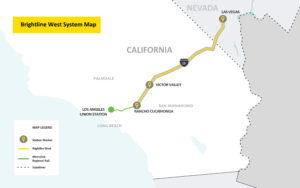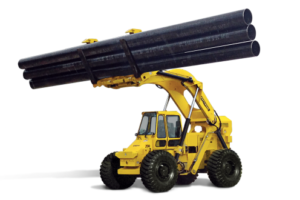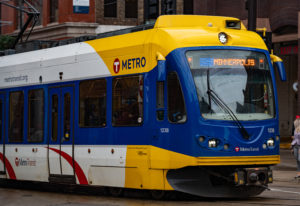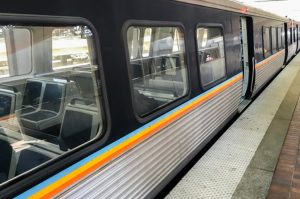No longer atypical
Written by Matt Alderton, Bentley Systems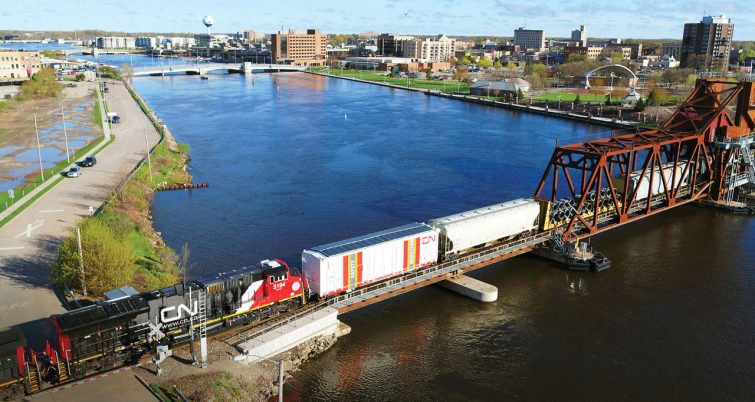
RT&S Editor’s Note: In August of this year, RT&S published a news story about the use of autonomous track inspection technology on the Canadian National Railway. The story has informative text and a couple of videos about CN’s strides with this technology. Previously, we had reported on autonomous track inspection technology using equipment mounted on locomotives at Norfolk Southern.
Our sister magazine, Railway Age, published a new story on CN’s autonomous track inspection technology today, and we have reproduced it below because of the groundbreaking nature of this new technology, and to add depth to our reporting. DCL
RAILWAY AGE, NOVEMBER 2020 ISSUE: CN’s Autonomous Track Inspection Program (ATIP) uses railcars equipped with sensors and artificial intelligence that automatically scan and analyze tracks while operating in revenue-service freight trains.
Despite the dramatic nature of railroad accidents, conveying goods and passengers by rail is the safest form of ground transportation when compared with other modes. Railway owner-operators are continually finding and implementing new safety innovations that could help prevent accidents and disruptions to service.
According to Federal Railroad Administration (FRA) data, there were more than 18,000 train accidents in the United States between 2010 and 2019. Though major ones are rare within the scope of MGTs (million gross ton-miles) and train-miles operated, they can impact the economy.
“Rail is the backbone of our supply chain, so major accidents, though few and far between, have huge economic impacts in terms of safety and reliability,” said Dan Vogen, Vice President of Road and Rail Asset Management at engineering software company Bentley Systems. Vogen has worked with transportation agencies for the past 27 years, focusing on asset inventory, operation, maintenance, analytics, and oversize/overweight permitting automation. Additionally, he works with global development and implementation teams in the U.S., Europe and Asia, supporting transportation asset management systems worldwide. He earned a Master of Science degree in computer science from the Illinois Institute of Technology.

While human error is the most common cause of train accidents, track defects are a close second, comprising more than 25% of all incidents, according to FRA. Fortunately, technology is giving railroads new ways to find such defects by measuring track geometry and detecting rail flaws more quickly, more often, more thoroughly and more precisely than was previously possible. The resulting data can help railways detect track defects before they become serious enough to cause a service disruption.
New technologies are now available that vastly improve inspection procedures, which were mostly done manually.
“Today, track maintenance is performed by highly trained professionals who use many different tools to visually inspect the tracks,” explained Rahim Karmali, Chief of Advanced Products and Technologies at Bentley Systems user CN. “The problem is: In order to do inspections, we still have to put people on equipment, on the tracks.” That means that rail operators sometimes have to strike a delicate balance between safety and uninterrupted service, the former of which CN would never compromise on.
“We operate more than 20,000 route-miles of track across North America in Canada and the United States. We touch three coasts—the Pacific, the Atlantic and the Gulf of Mexico—and our trains need to arrive on time in order to meet the demands of the U.S. and Canadian economies,” Karmali noted. “Putting people on the tracks to do inspections is akin to adding more vehicles on a busy highway during rush hour to inspect the pavement; it takes time and occupies network capacity.”

According to Karmali, the key to maximizing safety and performance is automation: using innovative and dependable technology rather than relying solely on people. In 2019, CN conceived its Autonomous Track Inspection Program (ATIP) to bring such innovations to life. Encompassing eight autonomous inspection vehicles—solar-powered railcars equipped with sensors and artificial intelligence that automatically scan and analyze tracks as they traverse them while operating in revenue-service freight trains—CN is on track to inspect 100% of its core network by the end of 2020.
“Placing advanced technology that’s capable of autonomously measuring track conditions on trains that already are moving across our network preserves existing capacity,” Karmali said. (Editor’s Note: Technology like ATIP has the potential to replace regular manual inspections required by FRA and Transport Canada. At this point, regulators, particularly those at FRA’s Research, Development & Technology arm, have been evaluating advanced technologies. It is hoped that rulemakings will be issued permitting such inspection procedures. —William C. Vantuono)
Autonomous technology improves and systemizes inspections, according to Bentley, whose data analytics and reality modeling software, AssetWise Digital Twin Services, helps CN exploit the data it collects by creating 3D digital replicas of its system with which to visualize, analyze and simulate maintenance needs and outcomes.
Consider, for example, the onboard sensors on CN’s ATIP railcars: Lasers measure track geometry with millimeter precision. Machine vision looks for missing or damaged components (e.g., rail cracks, loose joint bars, bad welds, missing fasteners, bad ties, etc.). Cross-plane LiDAR (Light Detection and Ranging) offers a 3D view of the right-of-way that reveals encroachments that may impede operations. Ground-penetrating radar scrutinizes the track subgrade for its drainage properties. Ultrasonic sensors reveal internal rail flaws that cannot be detected with the human eye. Replacing hi-rail inspection vehicles that cover the entire system a few times a year with ATIP-equipped railcars that can inspect track as often as they’re operating in revenue trains creates virtually continuous inspection.
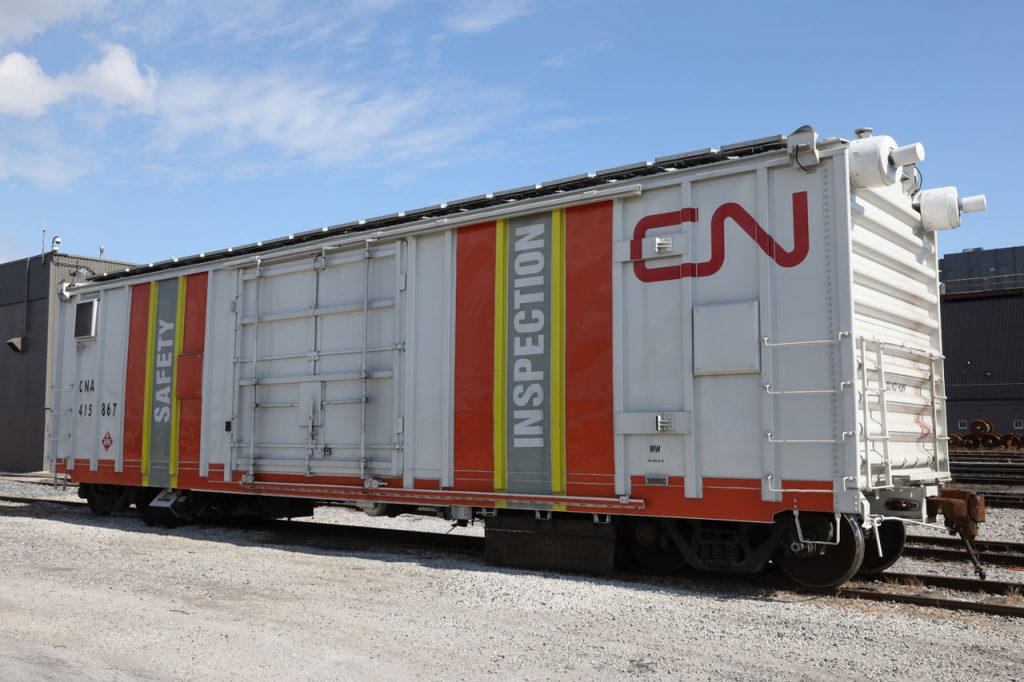
It’s patterned after a safety vest! CN/Bentley Systems
“Because these vehicles collect 10, 20, 30 or 40 very detailed types of measurements for every single foot that they travel, the amount of data we have now is huge,” said Bentley’s Vogen. In fact, the volume of data is so large that the only practical way to process it is with AI. To that end, forward-thinking railroads like CN are developing machine learning algorithms that use track measurements alongside variables like weather and tonnage to forecast maintenance needs before problems actually develop. On a single CN test corridor between Chicago and New Orleans (the former Illinois Central main line), for example, combining autonomous inspection with AI and machine learning has helped CN reduce track defects by as much as 90%.
“If we deal with data intelligently, it can help us identify changes and trends that we can share with CN for them to act on,” Vogen said.
And act CN does: When a potential safety problem is found, CN’s cloud-based ATIP system uses a wireless link to send a notification in near real time to track maintenance employees, who receive a diagnosis and GPS coordinates so they can address it. Simultaneously, machine learning algorithms digest the data in ways that help them forecast similar issues.
“In some cases, we’re collecting 20 gigabytes of data per mile. All that becomes part of our corporate memory, which allows us to track minor changes in the railway and gives us the ability to predict conditions before they occur, keeping our railroad even safer,” Karmali said. “Through the use of AI and big data, we’re transforming our team from ‘finders’ to ‘fixers.’”
Therein lies the promise of autonomous rail inspection: Time, resources and manpower that used to be consumed by assessing track conditions can be devoted, instead, to actually improving them. The advantages of this paradigm shift will be far reaching, benefiting the rail industry as a whole. “Utilizing tools like Bentley’s platform helps us determine exactly where we need to go and exactly what we need to do,” Karmali said. “We can visualize data and make effective decisions in response to it … It’s extremely powerful, and it’s already improving both the safety of our network and its capacity.”

